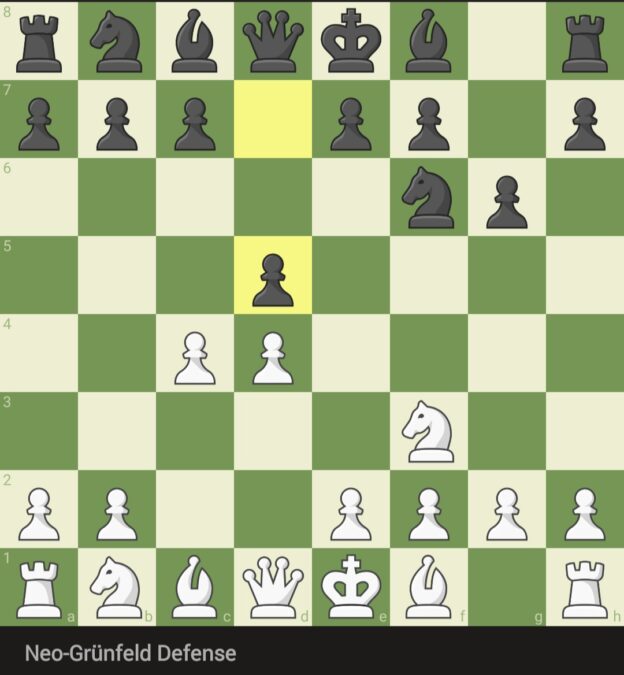In the ever-evolving world of chess openings, innovation and adaptability are key to staying ahead of the competition. The Neo Grünfeld Defense is a prime example of how chess players have adapted and modernized classical openings to meet the demands of the contemporary game. This essay delves into the history, principles, and strategic nuances of the Neo Grünfeld Defense.
Historical Context:
The Neo Grünfeld Defense is a development of the traditional Grünfeld Defense, a venerable opening that challenges White’s central control. The term “Neo” signifies a new or modern approach to this classic defense. While the Grünfeld Defense itself has a rich history dating back to the early 20th century, the Neo Grünfeld emerged as a response to evolving chess theory and the quest for fresh ideas.
Key Moves and Variations:
The Neo Grünfeld typically arises after the opening moves 1.d4 Nf6 2.c4 g6 3.Nc3 d5 4.Nf3 Bg7 5.Qb3. Black then plays 5…dxc4, deviating from the classical Grünfeld. This pawn capture leads to asymmetrical pawn structures and strategic complexities, setting the stage for modern battle.
Principles and Characteristics:
- Central Dynamics: The Neo Grünfeld retains the core idea of challenging White’s central control. Black aims to create dynamic imbalances by relinquishing the central pawn on d4, only to mount a counterattack later. The c4 and d4 pawns often become focal points of the game.
- Piece Activity: Piece coordination and activity are paramount in the Neo Grünfeld. The knight on f6, the bishop on g7, and the central pawns on d5 and c4 form a harmonious setup. Black often seeks to leverage this piece harmony for dynamic play.
- Modern Complexity: The Neo Grünfeld is characterized by modern complexity. The asymmetrical pawn structures and open lines often lead to intricate middlegame positions with tactical and strategic possibilities for both sides. This adaptability makes it an attractive choice for contemporary players.
Modern Relevance:
The Neo Grünfeld Defense remains highly relevant in modern chess. It is a popular choice among top-level players and club-level enthusiasts alike. Its capacity to create unbalanced positions and its adaptability to various pawn structures make it a versatile weapon for those seeking dynamic, fighting chess.
Famous Practitioners:
Top-level players have embraced the Neo Grünfeld as a valuable addition to their opening repertoire. Grandmasters such as Magnus Carlsen and Levon Aronian have employed it to great effect in their games, showcasing its adaptability and capacity to generate imbalanced positions.
Conclusion:
The Neo Grünfeld Defense epitomizes the ever-evolving nature of chess. By introducing fresh ideas and strategic flexibility to a classic opening, players have kept the spirit of innovation alive. Beyond its theoretical richness, the Neo Grünfeld is a reminder that in the world of chess, adaptation and creativity are the keys to enduring success. It underscores the dynamic and intellectual nature of the game, where tradition and innovation intertwine to create a tapestry of strategies and tactics.
